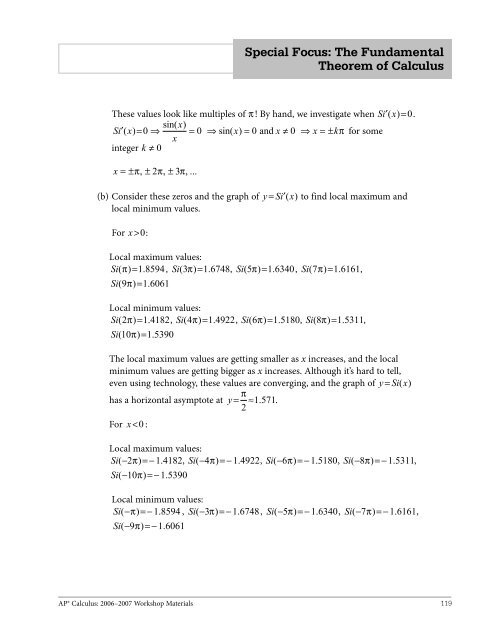AP Calculus
Calculus_SF_Theorem
Calculus_SF_Theorem
You also want an ePaper? Increase the reach of your titles
YUMPU automatically turns print PDFs into web optimized ePapers that Google loves.
Special Focus: The Fundamental<br />
Theorem of <strong>Calculus</strong><br />
These values look like multiples of π ! By hand, we investigate when Si′ ( x) = 0.<br />
sin( x)<br />
Si′ ( x)<br />
= 0 ⇒ = 0 ⇒ sin( x)<br />
= 0 and x ≠ 0 ⇒ x = ± kπ for some<br />
x<br />
integer k ≠ 0<br />
x = ± π, ± 2π, ± 3 π, ...<br />
(b) Consider these zeros and the graph of y = Si′( x) to find local maximum and<br />
local minimum values.<br />
For x >0:<br />
Local maximum values:<br />
Si( π ) =1.<br />
8594, Si( 3π ) = 1.<br />
6748, Si( 5π ) = 1.<br />
6340, Si( 7π ) = 1.<br />
6161,<br />
Si( 9π ) = 1.<br />
6061<br />
Local minimum values:<br />
Si( 2π ) = 1.<br />
4182, Si( 4π ) = 1.<br />
4922, Si( 6π ) = 1.<br />
5180, Si( 8π ) = 1.<br />
5311,<br />
Si( 10π ) = 1.<br />
5390<br />
The local maximum values are getting smaller as x increases, and the local<br />
minimum values are getting bigger as x increases. Although it’s hard to tell,<br />
even using technology, these values are converging, and the graph of y = Si( x)<br />
π<br />
has a horizontal asymptote at y = ≈<br />
2 1. 571.<br />
For x


